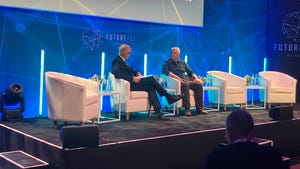Amazon starts selling private 5G, plants flag on pricing
Amazon Web Services said a construction company might pay $14,400 for three months of private 5G services in order to run security cameras across three floors of a building for eight hours each day.

Amazon Web Services (AWS) said it's now officially selling private wireless 5G services — and the company is promising offerings that cost just a few thousand dollars per month.
For example, the company said a university might pay just $14,000 for a complete network setup supporting 100 staff members with tablets and three months of service. Similarly, AWS said a construction company might pay just $14,400 for three months of service in order to run security cameras across three floors of a building for eight hours each day.
However, the company is also charging $10 per hour, with a minimum 60-day commitment, for each radio it supports. Some critics, including those from private wireless networking startup Celona, argued that kind of pricing could be "cost prohibitive" to enterprise customers deploying multiple radios for a more permanent operation.
The cloud computing vendor also included plenty of caveats with its offering, noting the product is still in development and will be fleshed out in the coming months and years. AWS said the service is currently only available in its US East (Ohio), US East (Virginia), and US West (Oregon) regions. The company also said it's not yet supporting an on-premise deployment of a core network. Instead, AWS said customers today can only run their core network operations inside a nearby AWS cloud computing region.
AWS said its "private 5G" service actually only runs on 4G LTE connections today. "The service supports LTE core and LTE radio units operating in the CBRS band, giving you the ability to connect your devices that support CBRS (LTE band 48) such as smartphones, tablets, Ethernet bridges, gateways, dongles, industrial CPE, and routers," AWS wrote on its website. "However, AWS Private 5G is built using a 5G service-based architecture (SBA), where 3GPP decomposed the core into network functions. With the SBA architecture, you can derive the benefits of private mobile networks today and seamlessly shift to 5G in the future."
Figure 1:  (Source: Unsplash)
(Source: Unsplash)
Nonetheless, Amazon's launch of its private 5G service is noteworthy considering it provides a very clear window into how the cloud computing giant plans to enter the private wireless network space, and how it might compete with the likes of Nokia, Verizon, Dish Network and others in a nascent but potentially lucrative sector of the telecom industry. However, few companies offer the kind of detailed pricing options that AWS is providing for its private 5G product.
The details
Amazon explained that its pricing contains no upfront fees or per-device costs, "and you pay only for the network capacity that you request."
The company provided several pricing scenarios – including the university and construction company examples – that help highlight Amazon's approach to private wireless pricing.
The company's pricing does not cover the cost of CBRS-capable phones or tablets, only the SIM cards that would be inserted into those gadgets. Also, those SIM cards must be purchased through Amazon, and the company does not support eSIM or other such technologies. Amazon is using 3.5GHz CBRS spectrum for its service, which is unlicensed and free to use.
But can a customer roam onto a public network, like one from Verizon or AT&T? "We are always working backwards from customer needs and will evolve the service based on customer demand," Amazon wrote in response to that question.
A major part of the cost of Amazon's service is the CBRS radios that customers can install either indoors or outdoors. Those radios broadcast the LTE signal that customers' phones, tablets or IoT devices would receive. Those radios cost $7,200 each for a 60-day commitment, according to the company's pricing examples. The company did not name the vendor it's using. However, Amazon did mention partners including Bearcom and Federated Wireless that can provide network planning and installation services.
The data costs
Amazon said customers must also pay for the data they use, albeit only in some situations. For example, in its university scenario, AWS said each tablet could send and receive 4 MB of Internet traffic every 5 minutes for 10 hours a day. "Your total Internet-bound data transfer is 2,860 GB per month. After your first 100 GB of internet-bound traffic per month, you pay $0.09 per GB for internet-bound data. This means that your data transfer costs are $248.40 per month," according to the company.
But the AWS construction company example includes no data fees. That's because the video is sent to Amazon Kinesis Video Streams for processing and analysis and "AWS does not charge data transfer from your data source writing to an Amazon Kinesis data stream," the company explained.
AWS' final pricing example involves a small manufacturing facility. "You want to use AWS Private 5G to send analytics data from your IoT devices to AWS IoT SiteWise to monitor and manage your equipment. You order an AWS Private 5G small-cell radio unit and 100 SIMs for your site. You install one SIM per IoT device. Each IoT device sends 3 kb of data every 60 seconds. Your total intra-Region data transfer is 13 GB per month. You pay $0.02 per GB for intra-Region data transfer. This means that your data transfer costs are $0.26 per month. You use AWS Private 5G for 60 days, at a cost of $7,200 per radio unit per 30 days. Your total cost for 60 days is $14,400.52," the company explained.
Amazon first announced its private wireless 5G service late last year in conjunction with its AWS re:Invent trade show. AT&T and Verizon executives have said the offering might complement their own private wireless networking ambitions, which sit squarely in the licensed spectrum realm.
However, AT&T's John Stankey has acknowledged that AWS could eventually step onto AT&T's toes in the private wireless networking sector. "Can we begin to move down market and offer more economical solutions that might meet the needs of the similar area where Amazon is trying to play? It's possible," Stankey said late last year. "But right now, we've got our hands full kind of at the upper end of the market."
Related posts:
— Mike Dano, Editorial Director, 5G & Mobile Strategies, Light Reading | @mikeddano
About the Author(s)
You May Also Like












